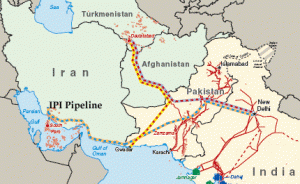 The proposed Iran-Pakistan (IP) pipeline, which would carry natural gas from Iran to Pakistan, recently made headlines as construction crews broke ground on the controversial project. The pipeline would transport an estimated 750 million cubic feet per day (mmcfd) of Iranian natural gas. That gas would go mostly to utilize Pakistan’s idle thermal power generation capacity.
The proposed Iran-Pakistan (IP) pipeline, which would carry natural gas from Iran to Pakistan, recently made headlines as construction crews broke ground on the controversial project. The pipeline would transport an estimated 750 million cubic feet per day (mmcfd) of Iranian natural gas. That gas would go mostly to utilize Pakistan’s idle thermal power generation capacity.
The U.S. opposes the project because it would provide an economic lifeline to Iran and undermine international sanctions. Iran’s clandestine nuclear program has rallied the international community to impose unprecedented sanctions, but the White House believes the IP pipeline would relieve pressure on the Iranian regime. In the Daily Briefing at the White House on March 1st, 2013, Acting Deputy Spokesperson Patrick Ventrell said,
“So if a deal were finalized for the proposed Pakistan-Iran pipeline, it would raise serious concerns under the Iran Sanctions Act. It’s still hypothetical at this point, but we’ve made that absolutely clear….as a member of the international community, a current member of the IAEA Board of Governors and the UN Security Council, Pakistan has an obligation to join multilateral efforts to convince Iran to adhere to international nuclear obligations.”
Despite warnings, the IP pipeline is being developed by a consortium of Pakistani public companies and Iranian companies to supply energy starved Pakistan with natural gas from Iran. Most of the pipeline on the Iran side is complete and Pakistan has begun work on its portion of the 485 mile run.
The U.S. believes a pipeline would enhance Iranian power in the region and provide Iran with hard currency revenues, which would ease the pressure of international sanctions. On the other hand, Pakistan has expressed an interest in maintaining close ties with Iran to ensure regional stability – and to receive natural gas at a reduced price.
Iran has provided Pakistan with a loan for its portion of the pipeline which is helping to fund the project. Moreover, Pakistan’s energy crisis is a real, pressing problem. Pakistanis are faced with blackouts for up to 6 hours daily because of the inadequate electricity supply and fragile grid. Pakistan would be able to import enough natural gas to support 4,000 megawatts of electricity capacity, about 80% of its power deficit.
Some analysts believe the forthcoming elections in Pakistan are putting pressure on the Pakistani People’s Party (PPP) to support the pipeline for political gain. Certain sectors of Pakistani society resent what they see as U.S. meddling, so by defying the U.S. the PPP could show its independence from Washington. It is also possible that after the election, the Pakistani government will cancel the project because of the cost.
For Pakistan, there are few alternatives to relying upon Iran for energy resources. The U.S. touted a Trans-Afghanistan Pipeline (TAPI), which would bring Caspian Sea natural gas from Turkmenistan to Afghanistan, Pakistan, and India. Not much progress has been made on this project in almost two decades. The United States has also proposed renovating hydroelectric dams to boost electricity output, as an alternative to the Iranian pipeline.
Ultimately, Pakistan needs sources of energy for its growing population. The economy often suffers from frequent blackouts. Moreover, in a country where anti-Americanism is rampant, there is political gain in flouting U.S. demands. This does not augur well for the U.S.-Pakistani relationship. However, due to the poor economics of the pipeline, many believe it will not be built. Still, the U.S. should increase its efforts in helping Pakistan diversify its energy resources to not only provide economic opportunity for Pakistan, but to also undermine Iranian influence in the region.


